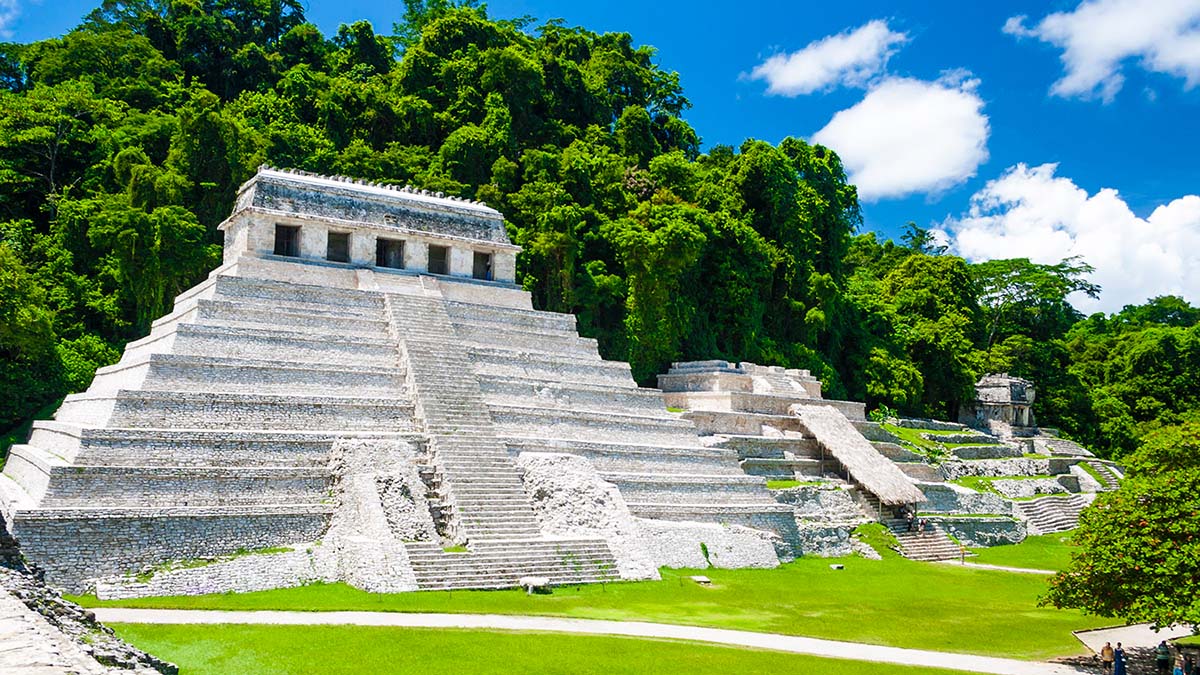
Palenque, Mexico
by W. Ruth Kozak
Many civilizations believe in reincarnation, a return to life after death. The credibility and mystery behind this doctrine has always fascinated me, in particular on those rare occasions when I have encountered a feeling of déjà vu. I recall an unusual dream I had and the strange occurrences that followed.
I am in a small room with walls made of white stone. The room is bare of furnishings except for a narrow bed covered by the pelt of a black animal, possibly a jaguar, and heaped with brightly colored cushions. In one corner is a large urn with a brilliant turquoise glaze, the most distinctive object in the room.
I am accompanied by another woman. We are both dressed in long gauzy garments and wear flower head dresses. She indicates to me that I am a captive and she is a servant.
I look out the narrow T-shaped window of the room and see a hilly landscape. A vista of lawns and foliage border a wide avenue that connects distant pavilions with curved roofs decorated by elaborate combs. Among the gardens and terraces are scattered other white stone buildings with carved lintels over arched doorways that are shaped like open serpents’ mouths. A stairway descends from the entrance of the room and below a crowd of people is assembling. The iridescent feathers of their headdresses make them look like a flock of exotic birds; the brilliantly dyed cloth of their garments swirls in a riot of colour as dancing men whirl to the pulsating bet of drums. The crowd screams and I see four people who appear to be captives being dragged up the steep stairs of an adjoining building. The moaning wail of a conch trumpet echoes off the hills. The hubbub of excited voices and the sound of scuffling footsteps on the stairs frightens me.
Two men enter the room. Both appear to be noblemen. They are dressed in garments of fine cotton cloth resplendent with painted and woven patterns. One is a full head taller than his companion. He is a handsome man with a beautiful sculpted face, high cheek-bones and a high-bridged nose. The short kilt he wears displays his bronze-skinned muscular body. He is adorned with exquisite jewelry, bracelets and rings of silver set with precious stones: turquoise, jade, lapis lazuli and pearls. Over his shoulders is draped a cape of brightly embroidered cloth and he wears a fabulous headdress of emerald-coloured plumes.
The men are conversing hushed, troubled voices in a language I do not understand. The tall, younger man joins me by the window. He looks down at the scene below. The mood of the crowd has intensified and the plaza resounds with the throbbing of drums and the piercing shrill of flutes.
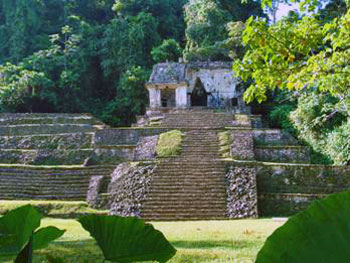 He gestures “trouble” and stands in front of me, placing his hands on my shoulders. His dark eyes penetrate me with their intenseness. A sharp pang of grief cuts through me. He stands quietly allowing me a moment of reflection. I realize then that, although I am his captive, I am also his lover.
He gestures “trouble” and stands in front of me, placing his hands on my shoulders. His dark eyes penetrate me with their intenseness. A sharp pang of grief cuts through me. He stands quietly allowing me a moment of reflection. I realize then that, although I am his captive, I am also his lover.
His eyes are sad and speak of tragedy. “You must go. I will help you escape…” He speaks his own language but makes me understand. He smiles to reassure me and embraces me. I smell the delicate fragrance of the perfumed oils he uses to anoint his body. “You must leave here,” he says. I protest. I do not want to leave him.
The other man who is waiting near the rear doorway with the woman servant interrupts, addressing his friend by name: “Cho’oc…Cho’oc-B’alam!” He speaks urgently in that strange langue of clucking sounds which I can not understand. Cho’oc pushes me toward the door. “You must go quickly…”
It is then that I wake from my sleep, but the dream, so vivid and real haunted me. Who was the man, Cho-oc Buhlum? Where was that place? Why was he sending me away?
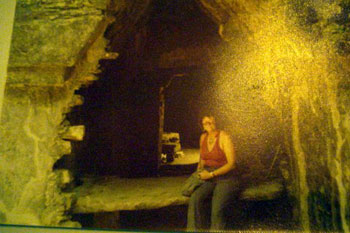 It wasn’t until nearly a year later in a place thousands of miles away in south-eastern Mexico that I would find some of the answers. I was traveling with two friends by van from the Mexican Caribbean coast of the Yucatan to the humid jungle area of the Chiapas, heading for the archaeological site of Palenque. We planned to spend the day exploring the ancient Mayan ruins. As I entered the site I was awed by what I saw. A mysterious jade-colored aura shimmers over the entire area where temples, palaces and pyramids with roof ornaments carved in stone preside magnificently over the gloomy, mysterious rain forest that surrounds it. It is easy to imagine every building in its perfection with the terraces and gardens that gave Palenque the reputation of having been one of the most beautiful of the ancient Mayan cities.
It wasn’t until nearly a year later in a place thousands of miles away in south-eastern Mexico that I would find some of the answers. I was traveling with two friends by van from the Mexican Caribbean coast of the Yucatan to the humid jungle area of the Chiapas, heading for the archaeological site of Palenque. We planned to spend the day exploring the ancient Mayan ruins. As I entered the site I was awed by what I saw. A mysterious jade-colored aura shimmers over the entire area where temples, palaces and pyramids with roof ornaments carved in stone preside magnificently over the gloomy, mysterious rain forest that surrounds it. It is easy to imagine every building in its perfection with the terraces and gardens that gave Palenque the reputation of having been one of the most beautiful of the ancient Mayan cities.
Known as a garden city of the Maya, Palenque was probably built some time after the fourth century AD when the Mayans developed a technique of constructing buildings of stone. Lost in the dense tropical forest, when it was rediscovered over 150 years ago, the jungle was set on fire in order to get at the collapsing buildings. Many of the priceless stucco reliefs crumbled and fell away. What remains is enclosed by a great green wall of jungle.
The Spanish named it “Palenque” which means “Palisade City”. Chol, a Mayan dialect still spoken by the natives translate the name as “Otot’(house) and “tun” (a stone) Otot-tun: Houses of Stone.
I wandered around the site from one building to another. The stone houses are abandoned now, these buildings and temples once occupied by venerable priests and Mayan nobility. The Grand Palace stands on a platform close to the middle of the city. The pyramids and temples group around it. My footsteps echo in the empty chambers. Water drips from the ceilings of dark passageways leading to underground galleries. The perfection of the architecture in Palenque is enhanced by the profusion of stucco reliefs found on the walls, cornices and pilasters of the palace. They rank among the finest works of Mayan art. It is dominated by a four-storied square tower known as the Observatory. Sculptures, burial chambers, inner courts and sandstone stelae flank the stairways and terraces. Across from it, the Sun Temple with its pierced roof comb, faces directly into the rising sun. I recalled seeing a building like this somewhere before: a vista of lawns and foliage bordering a wide avenue connecting distant pavilions that had curved roofs decorated with elaborate combs…
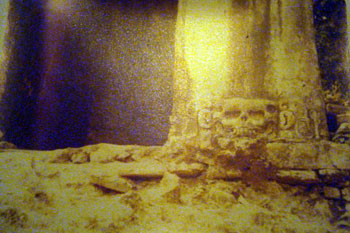 I walked from temple to temple. In each of those cool, damp sanctuaries, the spirits of former inhabitants whispered, waiting for recognition. The air was humid, carrying the fragrance of decaying and luxuriant growth and the scent of tropical flowers. Birds twittered gaily and fluttered about the roof-combs where they nested, the only inhabitants now.
I walked from temple to temple. In each of those cool, damp sanctuaries, the spirits of former inhabitants whispered, waiting for recognition. The air was humid, carrying the fragrance of decaying and luxuriant growth and the scent of tropical flowers. Birds twittered gaily and fluttered about the roof-combs where they nested, the only inhabitants now.
The Temple of Inscriptions dominates the scene, named this because of the three existing panels in the interior which bear the Inscriptions of Mayan laws. It is perched atop a massive pyramid. Deep inside the bowel of this pyramid is concealed the burial chamber of a Mayan priest-king, Pacal the Great.
I ascended the high steps to the top and sat to rest, contemplating the magnificence of the vista below, the lush landscape and surrounding monuments that lay scattered about the area of the temple-city. I imagined how it had been long ago when young men, chosen by the priests to be offered as sacrifices, climbed those steep steps, stopping on each platform to pipe a tune on his clay flute, then breaking the flute on the step as a symbolic gesture to the gods. I visualize people gathered in the plaza below, strange, beautiful people decked out in fantastic clothing covered with plumes of tropical birds.
At that moment the dream came back clearly to me. It was as though the missing pieces of a puzzle had been found and the picture became whole. I knew instinctively this was the place in my dream. I had been there before. And I knew that somewhere, among the surrounding temples, I would find the little room and perhaps the answer to the questions that had haunted me for so long.
Temple XII is a small stone house next to the huge pyramid of the Temple of Inscriptions. I had overlooked it when I first began to explore the site, because it is dominated by the massive structure of the pyramid and is set back among the trees. I made my way cautiously through the weeds and over the piles of stones, all that is left of a ruined terrace and crumbling stairway. As I entered the little room, a chill ran through me. I felt light-headed and my heart throbbed with excitement. In the dream, I entered the room through a small garden terrace. The rear wall of the structure was now partially crumbled and the terrace overgrown with vegetation and shattered mortar. The chamber ws much smaller than I remembered, yet I knew it was the same one. I remembered everything that had been in that room: a narrow bed covered by a jaguar pelt, a large urn with a brilliant turquoise glaze, the handsome dark-skinned man.
As I stood by the narrow T-shaped window and gazed out over the scene below, a sharp pang of remembered grief cut through my reverie. I was looking back into the past, imagining every building in its perfection with its terraces and painted ornaments carved in stone, a magnificent, awesome city with gardens of fragrant flowers and paved avenues. I summoned the strange foreign people of my dream who I imagined were gathered in the plaza below the steps. What had happened that long-ago day in Palenque? Who was Cho’oc B’alam, whose name means “The Young Jaguar”? Why had he wanted me to escape from there?
According to the guide-book, in another small temple – Temple XVIII – located behind Temple XII, excavators found a crypt containing the bodies of a young prince-priest and a girl who had been buried with him. Driven by insatiable curiosity, I decided to explore this site.
Dense underbrush had overgrown the path. I attempted to climb over the tangle of vines and foliage but it was impossible to locate the trail. I remembered that Palenque has also been called “Na-Chan”, City of Snakes, so I decided to turn back. But just then something caught my eye: a brilliant iridescent green feather. I remembered then, Cho-oc had worn a fabulous head-dress of emerald-coloured plumes.. Was this an omen? An answer to my questions? I turned back, unable to go any farther. The jungle would keep its secrets.
Later, I studied the photographs taken in Palenque, hoping to discover additional clues. A photo of Temple XII shows a close-up of the stucco relief carved at the base of the pillar at the front entrance. It is a carving of one of the Mayan death gods – a skull, outlined with decorative scrolls, after all these years unmarred by time. Strangely, there appears beside the pillar a mysterious vertical aura of purple light. The skull grins cryptically, keeping its secret and the secrets of the dead who still haunt the little stone house of Otut-tun.
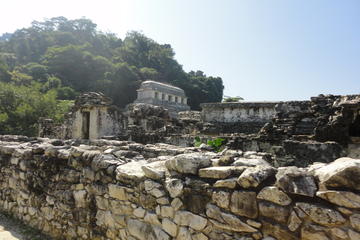
Palenque Archaelogical Site Tour and Misol-Ha Waterfall from Villahermosa
If You Go:
About the author:
Ruth is a historical fiction and travel writer. She had never forgotten the strange dream or her fascinating visit to Palenque. You can read more of Ruth’s published stories on her website at www.ruthkozak.com.
Photo credits:
Palenque by Jan Harenburg / CC BY
All other photos by W. Ruth Kozak




Leave a Reply
You must be logged in to post a comment.